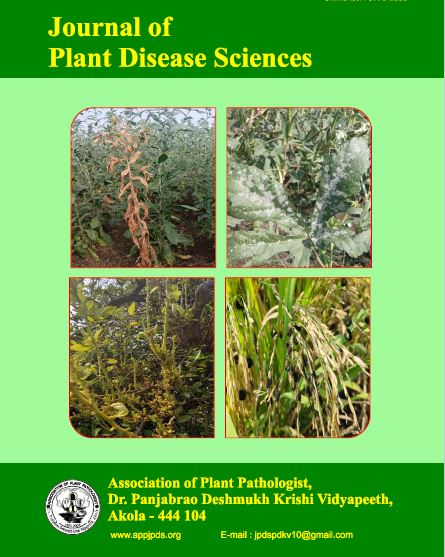SCREENING OF LINSEED ( L.) GERMPLASM UNDER EPIPHYTOTIC CONDITIONS AGAINST POWDERY MILDEW AND WILT DISEASES
DOI:
https://doi.org/10.48165/jpds.2025.20.01.08Keywords:
Linseed, Powdery mildew, Wilt, ScreeningAbstract
A set of 122 linseed germplasm accessions was evaluated for their resistance to powdery mildew and wilt diseases under epiphytotic conditions at the AICRP Linseed experimental block, College of Agriculture, Nagpur, during the cropping season of 2023–24. The objective of the study was to identify resistant sources for use in linseed breeding programs targeting disease resistance.Out of the 122 germplasm entries, nine accessions (23045, 24032, 24035, 24043, 24049, 24050, 24051, 25024, and 27025) exhibited a highly resistant response to powdery mildew. Furthermore, all entries were also tested under wilt sick plot conditions to evaluate their response to wilt disease. Among these, one entry (27042) showed a highly resistant reaction to wilt, while 12 entries (23054, 24031, 24036, 24041, 24042, 25021, 25023, 27021, 27025, 27030, 27033, and 27034) were categorized as resistant.The remaining accessions were classified as moderately susceptible, susceptible, or highly susceptible to one or both diseases.
References
Ajitkumar, K., Biradar, S.A.B., & Rajanna. (2015). Screening of linseed germplasm for resistance against powdery mildew caused by Oidium lini. Journal of Mycopathological Research, 53(2): 247–251.
Ajitkumar, K. (2020). Evaluation of linseed germplasm for resistance to powdery mildew under artificial inoculation. Unpublished Research Report, AICRP on Linseed.
Anonymous. (1997). Annual Report of Linseed 1996–97. All India Coordinated Research Project on Linseed, Project Coordinating Unit (Linseed), CSAU&T, Kanpur: pp. 51.
Anonymous. (2024). Annual Report, Linseed 2022–23. ICAR-Indian Institute of Oilseeds Research, Rajendranagar, Hyderabad-500030: pp. 212.
Dash, J., Naik, B.S., & Mohapatra, U.B. (2016). Field screening of linseed genotypes for resistance to powdery mildew (Oidium lini) in the north central plateau zone of Odisha. International Journal of Advanced Research, 4(4): 961–962.
Gill, K.S. (1958). Powdery mildew, a new disease of linseed in Punjab. Indian Oilseeds Journal, 2: 16–17.
Khare, D., Bhale, M.S., Nair, P., & Sinha, R. (2011). Sources of resistance to powdery mildew of linseed. Journal of Mycopathological Research, 49(1): 139–142.
kommedahl, T., Christensen, J.J., & Frederiksen, R.A. (1970). A half century of research in Minnesota on flax wilt caused by Fusarium oxysporum. Tech. Bull., Agric. Exp. Stn. No. 273.
Kushwah, U.S., & Chand, J.N. (1971). Efficacy of fungicides for control of powdery mildew of linseed (Linum usitatissimum) caused by Oidium lini. Indian Phytopathology, 24: 200.
McKinney, H.H. (1923). Influence of soil temperature and moisture on infection of wheat seedlings by Helminthosporium sativum. Journal of Agricultural Research, 26: 195–217.
Sharma, H.C., & Khosla, H.K. (1976). Fungicidal control of powdery mildew of linseed (Linum usitatissimum) in relation to yield losses. JNKVV Research Journal, 10: 161–162.
Singh, J., Singh, P.K., & Srivastava, R.L. (2017). Diseases of linseed (Linum usitatissimum) in India and their management – A Review. Journal of Oilseeds Research, 34(2): 52–69.
Skoric. (Year not specified). Journal of Mycopathological Research, 53(2): 247–251.
Wheeler, B.E.J. (1969). An Introduction to Plant Diseases. The English Language Book Society and Wiley & Sons Ltd.

